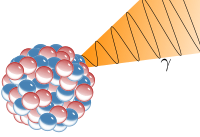
Photo from wikipedia
Preclinical and clinical studies have shown that traumatic hemorrhage (TH) induces early complement cascade activation, leading to inflammation-associated multiple-organ dysfunction syndrome (MODS). Several previous studies have demonstrated the beneficial effects… Click to show full abstract
Preclinical and clinical studies have shown that traumatic hemorrhage (TH) induces early complement cascade activation, leading to inflammation-associated multiple-organ dysfunction syndrome (MODS). Several previous studies have demonstrated the beneficial effects of complement inhibition in anesthetized (unconscious) animal models of hemorrhage. Anesthetic agents profoundly affect the immune response, microcirculation response, and coagulation patterns and thereby may confound the TH research data acquired. However, no studies have addressed the effect of complement inhibition on inflammation-driven MODS in a conscious model of hemorrhage. This study investigated whether early administration of decay-accelerating factor (CD55/DAF, a complement C3/C5 inhibitor) alleviates hemorrhage-induced organ damage and how DAF modulates hemorrhage-induced organ damage. DAF was administered to unanesthetized male Sprague Dawley rats subjected to pressure-controlled hemorrhage followed by a prolonged (4 h) hypotensive resuscitation with or without lactated Ringer’s (LR). We assessed DAF effects on organ protection, tissue levels of complement synthesis and activation, T lymphocyte infiltration, fluid resuscitation requirements, and metabolic acidosis. Hemorrhage with (HR) or without (H) LR resuscitation resulted in significantly increased C3, C5a, and C5b-9 deposition in the lung and intestinal tissues. HR rats had significantly higher tissue levels of complement activation/deposition (particularly C5a and C5b-9 in the lung tissues), a higher but not significant amount of C3 and C5b-9 pulmonary microvascular deposition, and relatively severe injury in the lung and intestinal tissues compared to H rats. DAF treatment significantly reduced tissue C5b-9 formation and C3 deposition in the H or HR rats and decreased tissue levels of C5a and C3 mRNA in the HR rats. This treatment prevented the injury of these organs, improved metabolic acidosis, reduced fluid resuscitation requirements, and decreased T-cell infiltration in lung tissues. These findings suggest that DAF has the potential as an organ-protective adjuvant treatment for TH during prolonged damage control resuscitation.
Journal Title: International Journal of Molecular Sciences
Year Published: 2022
Link to full text (if available)
Share on Social Media: Sign Up to like & get
recommendations!